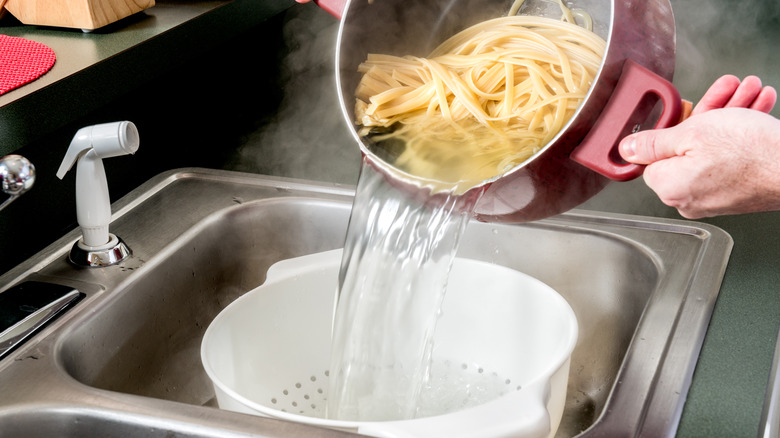Apparently We've All Been Using Strainers Totally Wrong
When you're making spaghetti and you get done boiling the noodles, what do you use to drain off the water? A strainer. When you're making a puree out of mashed-up berries, what do you use to filter the seeds out of the juice? If you said a strainer, you'd be right on the money. A strainer, whether it's plastic or metal, is incredibly useful for separating liquids from solids. It keeps pulp out of your juices or purees, helps you to drain pasta water, and helps you to strain stock to filter out impurities.
The next question we have to ask you is one you'll most likely have an obvious answer to. How do you normally use a strainer? Some of you may say that you just put the strainer in the sink and dump whatever it is you're trying to drain liquid from into it. Others may say they put in the strainer above a wide deep pot or dish and let the liquid drain into it. While these are all objectively "correct" ways to use a strainer, there are those who argue that it's actually not the correct way to use it. Of course, that raises another question: What exactly is the right way to use a strainer if all the other ways listed are somehow incorrect?
The answer to this question isn't about how you use the strainer, per se. It's about where you put the strainer when you're using it — it should be inside the pot itself.
Put the strainer inside the pot before you drain the liquid
You'll remember one of the methods of using a strainer mentioned above has you putting the strainer in the sink and then dumping whatever it is you're draining into it. This way, the liquid you're trying to get rid of just goes down the drain. While this is a good method to keep your kitchen space, the "correct" method has you put the strainer or colander into the pot itself instead of resting it in the sink.
Rather than putting your strainer in the sink and dumping your pot of, say, boiling spaghetti into it, you just take the strainer and put it above the pot. You should sink the bottom of the strainer into the water or whatever liquid it is you're straining, while the wide rim of the strainer keeps it from falling into the pot. Once you put the strainer into your pot, you can then pour the liquid into the sink or cooking dish as you usually would.
What exactly makes this method so good? For starters, this achieves the same effect as pouring the contents of the pot into the strainer separately, with the pasta being kept inside the pot by the strainer while the liquid pours out through the holes — but with much less risk of scalding yourself. You also don't lose any noodles in the sink as you pour, which makes this method not just a bit safer but easier to do.
Some seem to be unconvinced this isn't the right way
All in all, the correct way to use a strainer doesn't seem to be anything too mind-blowing at first glance. You're still using the strainer as you normally would, just in a different position than you'd expect. To some, however, this method wasn't as genius as it's made out to be, with some even saying it was more dangerous than the original, traditional method many use. This is evident by the comments on TikTok user "johannawestbrook's" video showcasing the correct strainer method.
"A friend of mine did it like this so at my house he did it with my plastic strainer and it 100% melted and ruined my strainer," reported one user. "It has a foot rim on it for a reason. It's meant to sit down on something (probably the bottom of the sink)," commented another user. "This is a great way to burn yourself." Others, however, seemed more accepting of this unconventional method than others were.
"It is genius!!! Agreed!!!" raved one user. "There is a difference, less chance getting burned and making a mess! Thanks for sharing." "Been doing it this way for years. Prevents pasta from slipping through the holes in the strainer," said another user. It seemed the comments were divided as to whether or not this was a useful cooking trick or something that was more trouble than it was worth. It seems you'll have to try it for yourself to be the judge.

